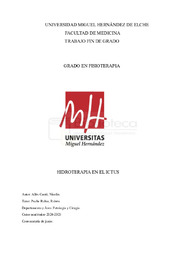Por favor, use este identificador para citar o enlazar este ítem:
https://hdl.handle.net/11000/37436Registro completo de metadatos
| Campo DC | Valor | Lengua/Idioma |
|---|---|---|
| dc.contributor.advisor | Puche Rubio, Rubén | - |
| dc.contributor.author | Allés Cantó, Nicolás | - |
| dc.contributor.other | Departamentos de la UMH::Patología y Cirugía | es_ES |
| dc.date.accessioned | 2025-09-17T08:50:13Z | - |
| dc.date.available | 2025-09-17T08:50:13Z | - |
| dc.date.created | 2025-05-23 | - |
| dc.identifier.uri | https://hdl.handle.net/11000/37436 | - |
| dc.description.abstract | Introducción: El ictus se define como la interrupción del suministro de sangre al cerebro de más de 24 horas de evolución, lo que lleva a una pérdida rápida de las funciones cerebrales. A pesar de los avances en prevención y en el tratamiento, se prevé un aumento de los accidentes cerebrovasculares en los próximos años. La hidroterapia, gracias a sus características y propiedades termodinámicas, ha ganado una mayor relevancia en la rehabilitación tras un accidente cerebrovascular. Objetivos: Realizar una revisión de la literatura para determinar la eficacia de la hidroterapia en la rehabilitación de pacientes que han sufrido un ictus. Material y métodos: Se realizó una búsqueda bibliográfica en las bases de datos Pubmed, PEDro y CINAHL, desde los últimos 10 años. Resultados: Se incluyeron 12 ensayos con un total de 655 sujetos. El equilibrio y la marcha fueron las dos variables más estudiadas, en un 75% y 66,6% respectivamente, lo que nos muestra el gran peso que tienen en la rehabilitación. También se estudian otras variables como la fuerza y función motora, calidad de vida o dolor. La Berg Balance Scale (BBS), Time up and go (TUG) y la prueba de marcha de los 2 minutos (2MWT) han sido las escalas más utilizadas entre otras. Conclusiones: A pesar de que no hay mucha evidencia científica, la hidroterapia combinada con un tratamiento convencional o como único tratamiento, puede ser una gran alternativa en la rehabilitación del ictus. | es_ES |
| dc.description.abstract | Introduction: Stroke is defined as the interruption of blood supply to the brain for more than 24 hours, leading to a rapid loss of brain function. Despite advances in prevention and treatment, stroke is expected to increase in the coming years. Hydrotherapy, thanks to its characteristics and thermodynamic properties, has gained greater relevance in post-stroke rehabilitation. Objectives: To conduct a literature review to determine the efficacy of hydrtyherapy in the rehabilitation of stroke patients. Material and methods: A bibliographic search was carried out in the Pubmed, PEDro and CINAHL databases for the last 10 years. Results: Twelve trials were included with a total of 655 subjects. Balance and gait were the two most studied variables, 75% and 66.6% respectively, which shows the great weight they have in rehabilitation. Other variables such as strength and motor function, quality of life and pain were also studied. The Berg Balance Scale (BBS), Timed Up and Go (TUG) and the 2 minute gait test (2MWT) were the most used scales among others. Conclusions: Although there is not much scientific evidence, hydrotherapy combined with convencional treatment or as the only treatment, can be a great alternaative in stroke rehabilitation. | es_ES |
| dc.format | application/pdf | es_ES |
| dc.format.extent | 37 | es_ES |
| dc.language.iso | spa | es_ES |
| dc.publisher | Universidad Miguel Hernández | es_ES |
| dc.rights | info:eu-repo/semantics/openAccess | es_ES |
| dc.rights | Attribution-NonCommercial-NoDerivatives 4.0 Internacional | * |
| dc.rights.uri | http://creativecommons.org/licenses/by-nc-nd/4.0/ | * |
| dc.subject | ictus | es_ES |
| dc.subject | hidroterapia | es_ES |
| dc.subject.other | CDU::6 - Ciencias aplicadas | es_ES |
| dc.title | Hidroterapia en el ictus | es_ES |
| dc.type | info:eu-repo/semantics/bachelorThesis | es_ES |

Ver/Abrir:
ALLÉS CANTÓ, NICOLÁS.pdf
958,48 kB
Adobe PDF
Compartir:
 La licencia se describe como: Atribución-NonComercial-NoDerivada 4.0 Internacional.
La licencia se describe como: Atribución-NonComercial-NoDerivada 4.0 Internacional.
.png)